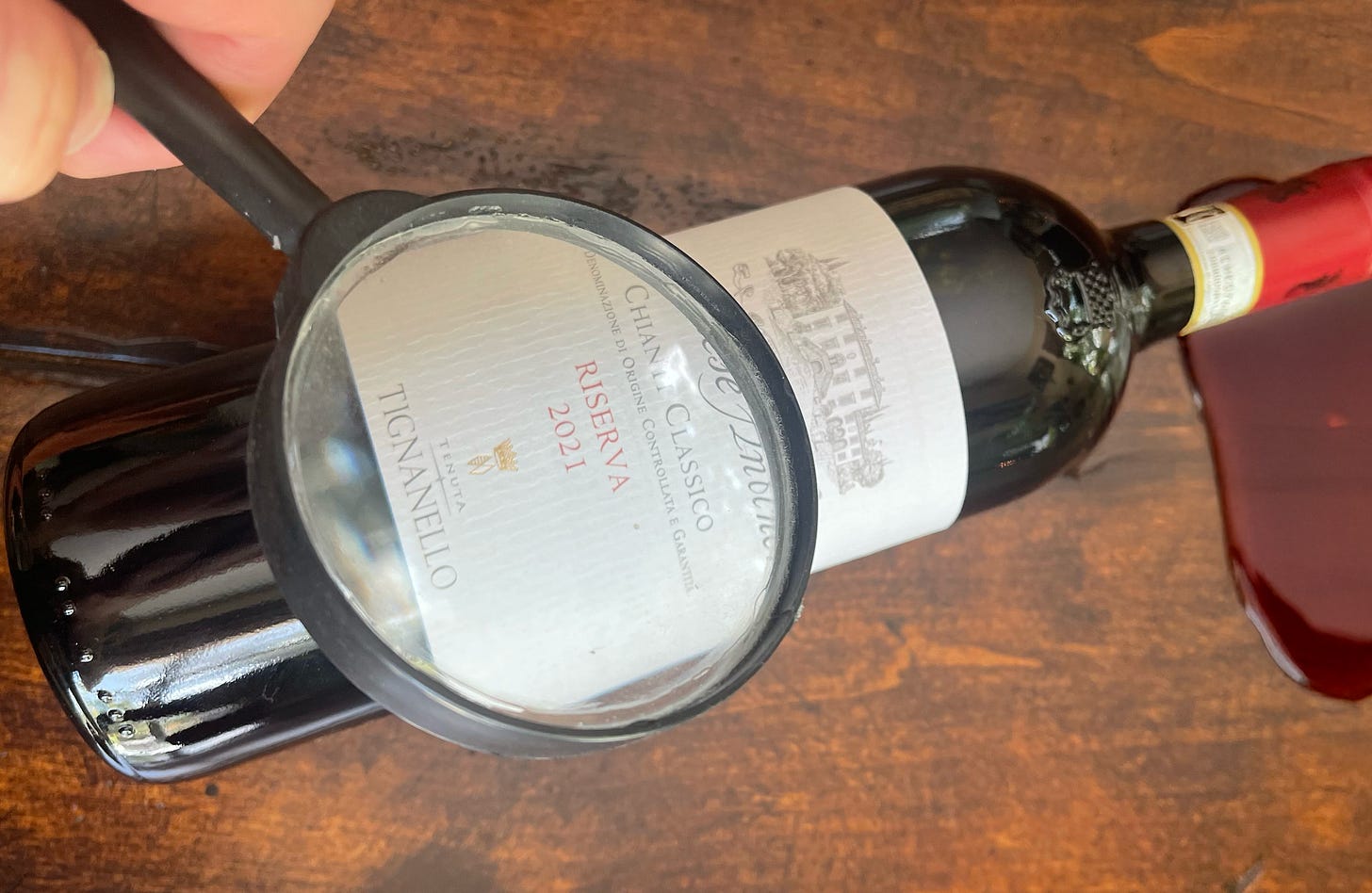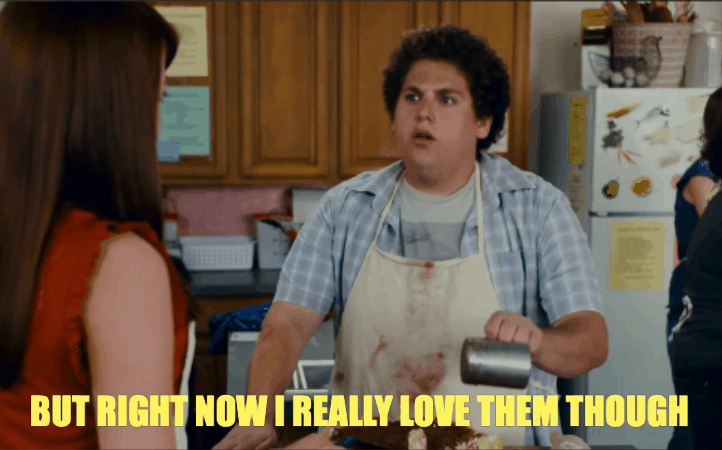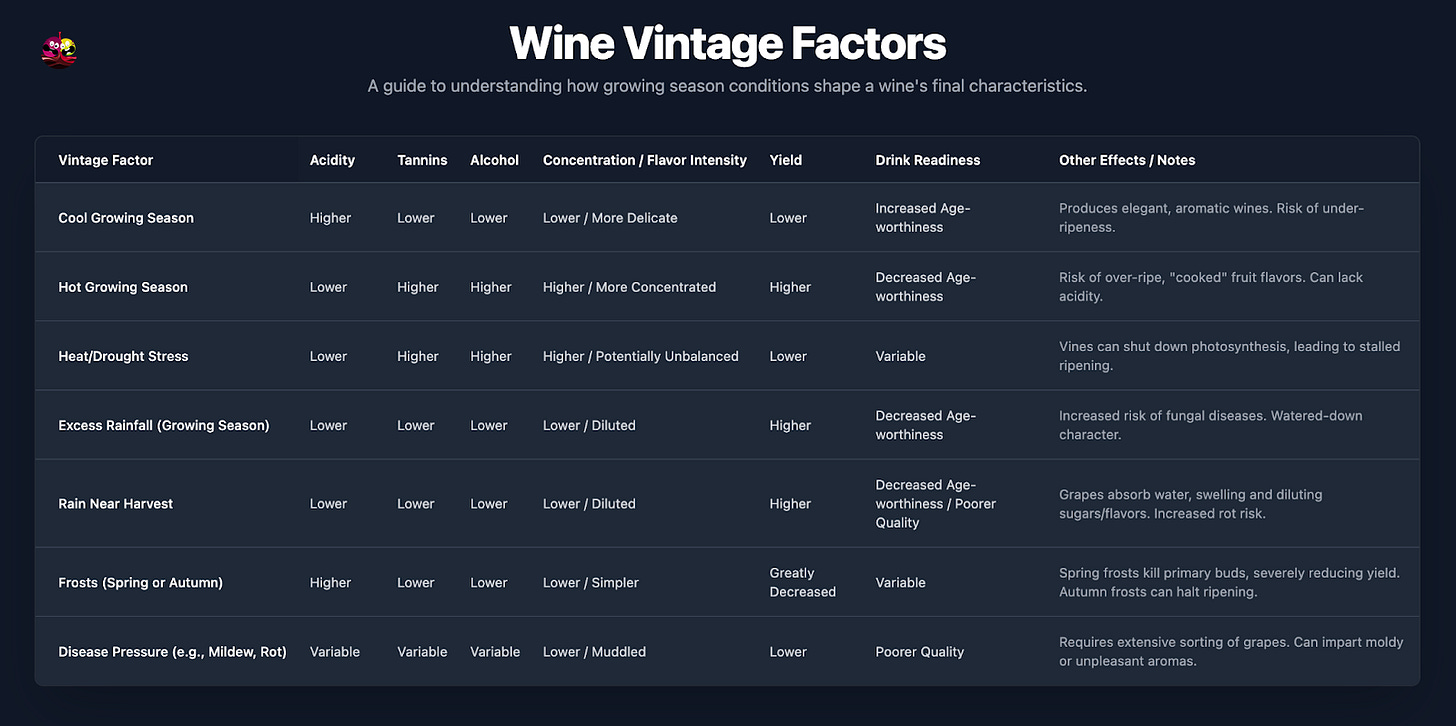Tannic Panic! Issue #125: Why Vintages Matter (And Why They Also Don’t)
A little look-see at what vintage really says about a wine
Here at Tannic Panic we often find ourselves struggling to even identify what year we’re living in, let alone the year printed on the bottle. But on those special, rare occasions that our faculties remain adequately tethered to reality, we’ve found “vintage” to be a useful way of garnering some “information” about the wines we buy.
But what does “vintage” really mean, and how much weight should you give to that “year” on the label?
Let’s Begin with “the Basics”
If we’re waxing poetic, the humble “vintage” might be described as a year’s worth of “nature” compressed into a fleeting moment of Zeus-juician glory (or disappointment). More simply put, a wine’s vintage is just the year the grapes were harvested (not the year it was bottled, nor the year the tiny berries were “born”).
But it’s more than just a number – when taken in tandem with region, it carries with it the story of everything that “transpired” in the vineyard: rainfall and drought, heat spikes and cold snaps, “intimate moments” and even “friendly visits” from “local pests” (LIKE ME!).
These unpredictable factors shape the balance of sugar and acid, the ripeness of tannins, the intensity of aromatics and the very integrity of the everloving berries we all so desperately “rely on.”
Some years are immediately hailed as “great” (e.g., 2021 in Tuscany or 2018 in Bordeaux) while others are quickly written off. But the truth is more complicated.
Vintage as a Guide, Not a Gospel
We like to stay “up to date” on vintage reports for any regions we “study by the glass.” These reports are updated regularly and have varying focuses (e.g., an overall grade of the vintage, a summary of the conditions of the growing season, readiness for drinking, etc). And while all of those things can be useful and we strongly encourage giving them a proverbial “gander” if you haven’t, they should never be treated as universal truths. A “five-star” vintage doesn’t mean every wine is excellent, just as a “poor” one doesn’t doom all bottles to “plonkocrity.” In fact, depending on the basis for those scores, you may find that you actually tend to prefer wines from a so-called “lesser” vintage.
HERE’S WHY:
Regions are mosaics. A report on Tuscany might declare a vintage “hot,” but say little about a high-elevation vineyard in Chianti Classico where cooler nights preserved acidity, or a coastal Bolgheri site where consistent breezes balanced out a hot summer. In places like Sonoma, microclimates can vary dramatically within a few miles. Our foggy little friend the “Russian River Valley” might as well be a world away from the sun-baked Dry Creek in some years. That doesn’t mean there aren’t potentially blanket truths in a region, but it does mean that the reality is more “nuanced” than a broad report might suggest.
Expectations are benchmarked. Against “recent successes” and against “popular styles” of the time. Example: Modern “excellent” Bordeaux vintages (e.g. 2009, 2010, 2016, 2018, 2019) are riper and more extracted in style with higher ABVs (14-15%) in contrast to the “clarets” of yore. Wines that were once lauded might generally score lower as a result were they to be produced today.
Taste is subjective. Wines from a cooler-than-typical vintage might be higher in acid and lower in alcohol than usual for the region, but that doesn’t inherently make them worse. Believe it or not, YOU get to decide.
“Bad” Vintages Can Shine
Ironically, a “lesser” vintage is sometimes the better choice today. Wines from cooler, rainier years often mature faster and can show beautifully in their youth, while highly rated vintages might need years (or decades) to “unfurl” their “angry little tannins.” A 2021 Bordeaux might be accessible and ready to drink now (LIKE ME), while a brooding, tannic 2020 still begs for “patience” to allow its true “greatness” to evolve.
And we can’t reiterate enough that what counts as “great” depends on your taste. If you like fresher, more acid-driven reds, you might prefer “challenging” years to the blockbuster, “global warming” driven ones.
How “We” Judge a Vintage
Benchmarking a vintage usually means comparing it to a region’s historical average — for ripeness, concentration, balance, or aging potential. But that’s inherently subjective. Is “classic” Bordeaux cool and restrained, or lush and opulent? The answer depends on your palate and on how climate change and global preferences for “Parkerized” styles are reshaping those expectations.
Nonetheless, by exposing yourself repeatedly (in private) to specific vintages, you can start to develop some benchmarks of your own. Even a single benchmark vintage can be a sufficient datapoint for directional guidance from a vintage chart. By knowing how you feel about a certain vintage (ie, how well was it balanced? Concentration levels? Astringency?) you can more reliably leverage information about how other vintages differed. Here’s a wholesome little table with some directional guidance on how differences in vintages might actually impact the wine you are drinking.
Many of these factors have effects that are a bit more complex than can be captured by a table like this. For example, a hot growing season is likely to decrease acidity, which in turn tends to decrease age-worthiness, but if a wine is already very high acid, the increase in alcohol and concentration of flavors might actually make the wine more age-worthy. In other words, there is context dependence, so it’s better to focus on the directional influences relative to your own benchmarks when applying this logic.
2021 “Case Study” in Bordeaux & Tuscany
Bordeaux 2021: Classical and Cool
After the warmth and concentration of the excellent string of 2018 to 2020 vintages, 2021 was a “return” to old-school Bordeaux (THE GOOD KIND?): cooler temperatures, lower yields, and fresher profiles. Many wines are lighter, with red-fruited aromatics, crisp acidity, and moderate alcohol. Critics were initially “lukewarm,” but producers who “managed their canopies” carefully and “picked their berries” selectively crafted beautifully balanced wines that are already approachable. Compared to the powerful 2020s, some might find 2021 to feel like a “literal breath” of fresh air; nice for near- to mid-term drinking, less extracted and lower in alcohol.
Tuscany 2021: Balanced and Bright
Tuscany saw a relatively steady growing season in 2021 after the warmth of 2020. Conditions were dry but not scorching, producing wines with vibrant acidity, ripe but not jammy fruit, and fine tannins. Chianti Classico in particular excelled, offering a blend of freshness and structure that harks back to traditional styles. While 2016 or 2019 may still be more ageworthy benchmarks, 2021 is a vintage that is already highly drinkable and has been rated as the strongest vintage in “recorded history” by Wine Spectator. The wines are concentrated and aromatic, with great structure, but perhaps less “elegance” than the humble 2022 vintage that followed (which pales in comparison by ratings, but may well be more suited to “your” palate).
… AND NOW FOR THE REVIEWS (IN ORDER OF PRICE):
[CLICK HERE FOR A BREAKDOWN OF HOW OUR 100PT RATING SYSTEM WORKS]
2021 Antinori Marchese Chianti Classico Riserva / $50
Profile: Ripe cherries, bramble fruit, chocolate, orange peel, thyme, potpourri, mint, forest floor, copper penny
Palate: Dry, medium+ tannin, high acid, long finish, medium+ bodyA beautifully balanced and powerful wine from the Antinori family, made with grapes exclusively from the Tignanello vineyard (but at a fraction of the price of Tignanello proper). As Chianti Classico goes, the price is definitely “premium,” but so is the wine, and it shares many of the distinctive stylistic qualities of big boi Tignanello. This is a bottle that truly illustrates the potential of the vintage. Had I not spent me last few coppers on this bottle, I’d have tracked down a 2020 or 2022 for comparison. Suffice to say, twas good.
Score Breakdown: Balance 38 / Aroma/Flavor 18 / Concentration 15 / Length 15 / Complexity 8 = 94 Points (I)
2021 Chateau Ferriere, Margaux / $62
Profile: Blackcurrant, blackberry, plum, raspberry, tart blueberry, cedar, wet leaves, tobacco, violets, mixed spice, cocoa
Palate: Dry, full body, high acid, long finishBlend: 81% Cabernet Sauvignon, 13% Merlot, 5% Petit Verdot, and 1% Cabernet Franc
This wine channels the 2021 vintage’s cooler, more restrained “old school Bordeaux” style—with vibrant (but still concentrated) black and red fruits, high acidity, high tannins, cedar, herbaceous notes and lower alcohol (13%) than prior recent vintages. After the plush richness of 2018–2020 Bordeaux vintages, this 2021 is made in the so-called “proper claret” style of the “olden days,” before global warming started “having its way” with many recent vintages.
Score breakdown: Balance 36 / Aroma/Flavor 17 / Concentration 15 / Length 15 / Complexity 8 = 91 Points (Z)
If you really want to pinpoint key differences by vintage, one of the best ways to do that is to “engage” in vertical tastings, which draws its name from the challenge of “remaining vertical” while tasting the same wine from many different vintages. This “field test” allows you to isolate the variable of vintage while keeping factors like producer, varieties, and region consistent.
When it’s all said and done, a vintage is but a clue, not a verdict, and the best way to understand it is still the old fashioned way – imbibe.
Until next time, HAPPY DRINKING PEOPLE.
Cheers,
Isaac & Zach










We're seeing this right now with James Molesworth give the 2022 Vintage in Napa a lower score than 2020. That 2020, the fire year. So a heat dome in 2022 is worse than smoke taint? Nah, not buying it.
Don't panic. Enjoy